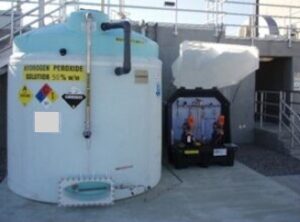Hydrogen Peroxide Injection System in Action: Solving Real Odor Problems in Wastewater Operations
 Hydrogen peroxide has become a practical tool for many wastewater treatment systems. It’s commonly used to reduce odors and limit corrosion caused by hydrogen sulfide. While the science behind the process is straightforward, not every facility has seen how a hydrogen peroxide injection system works in a real setting.
Hydrogen peroxide has become a practical tool for many wastewater treatment systems. It’s commonly used to reduce odors and limit corrosion caused by hydrogen sulfide. While the science behind the process is straightforward, not every facility has seen how a hydrogen peroxide injection system works in a real setting.
At Webster Environmental Associates (WEA), we work directly with municipal and industrial clients to design and install these systems. We’ll explain how hydrogen peroxide injection works, where it’s being used successfully, and what facilities need to think about before getting started.
How Hydrogen Peroxide Injection Works in Practice
A hydrogen peroxide injection system is designed to add the chemical directly into wastewater lines. The most common application is in force mains or gravity sewers where hydrogen sulfide builds up. These lines usually have low oxygen and long detention times, which creates the perfect conditions for odor problems.
In most cases, we inject hydrogen peroxide 10 to 20 minutes upstream of the odor release point. The reaction happens quickly. Hydrogen peroxide oxidizes hydrogen sulfide, turning it into water, oxygen, and elemental sulfur or sulfate, depending on the reaction.
The dosing system is designed to match the flow and sulfide load. That means it can change based on time of day, weather, or other operating conditions. WEA uses flow meters, sulfide data, and sometimes even H2O2 sensors to keep the system running effectively. The goal is to provide enough peroxide to treat the odor without wasting chemical or creating other problems.
Where It’s Being Used Successfully
Hydrogen peroxide injection is already helping many facilities across the U.S. manage tough odor challenges. One of the most common uses is at pump stations that release strong odors into nearby neighborhoods. These stations are often surrounded by homes or businesses, so reducing odor is a top priority.
Another common application is at treatment plant headworks, especially in summer. Higher temperatures speed up biological activity and sulfide production. Hydrogen peroxide is often used to reduce peak odors during these warm-weather periods.
Some systems also use peroxide as a short-term measure during equipment failures. If a biofilter, scrubber, or fan system goes offline, peroxide can fill the gap. In other cases, it’s used while a permanent odor control system is being built. This flexibility makes it a useful option in many emergency or transitional situations.
Benefits That Facilities Notice
The most obvious benefit of a hydrogen peroxide injection system is fast odor reduction. Once peroxide enters the stream, it starts reacting right away. Most facilities notice a drop in odor within hours of startup. This is especially important in areas with public complaints or strict air quality regulations.
Unlike nitrate or magnesium hydroxide, hydrogen peroxide does not add nutrients or organics to the wastewater. That can be helpful in systems that are trying to manage nutrient loading or where biosolids quality is a concern.
Another benefit is that peroxide systems usually don’t require a big investment in new infrastructure. A typical setup includes a chemical storage tank, a metering pump, and some basic controls. That means it’s often possible to solve odor problems quickly without waiting on large capital projects.
Hydrogen peroxide can also help stabilize conditions when other systems aren’t enough. If you’re running a biofilter or scrubber that’s not handling all the odor, peroxide can reduce the load going into those systems. That can make them more effective and improve overall performance.
What You’ll Need to Run It Safely
While peroxide is effective, it must be handled with care. It’s a strong oxidizer and is classified as a hazardous material. That means proper planning is important before starting an injection system.
You’ll need chemical storage tanks designed for peroxide, along with metering pumps that can handle the material. WEA also recommends secondary containment in case of spills, and we help design that into each system.
Operators will need some basic safety training. That includes how to wear protective gear, read signage, and manage accidental exposure. WEA provides training and setup support to make the process easy. We also help clients select equipment that is safe and reliable.
In most cases, the safety needs are manageable and can be built into daily operations without major changes. WEA works closely with your staff to make sure the system is both effective and safe.
How WEA Designs and Supports Hydrogen Peroxide Systems
No two facilities are the same, and hydrogen peroxide injection systems must be customized. At WEA, we start with an odor evaluation to understand the specific problem. We collect air and liquid samples, measure hydrogen sulfide levels, and review flow data.
From there, we recommend a dosing strategy. We size the storage and feed equipment based on expected use. We also plan for flexibility so the system can adapt to seasonal changes or new operating conditions.
Once the system is installed, WEA stays involved. We offer follow-up testing, help adjust dosage levels, and check on performance. If the system needs changes, we’re available to help.
Looking Into Hydrogen Peroxide Injection? Reach Out Today
Hydrogen peroxide can be a strong option for odor control, especially in systems dealing with hydrogen sulfide and limited treatment time. It’s fast, flexible, and effective—but only when applied the right way.
WEA has years of experience designing hydrogen peroxide injection systems that work in real conditions. We take the time to understand your needs and build a system that fits your operation.
If you’re considering this method or need help solving odor issues, reach out to us today. We can help you plan a system, run a test, or review other options that may work for your site.
